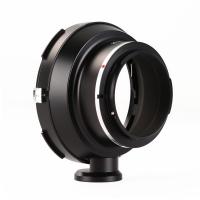What Is The Magnification Of A Electron Microscope ?
The magnification of an electron microscope can vary depending on the specific type and settings of the microscope. However, electron microscopes are capable of achieving much higher magnifications compared to optical microscopes. They can typically magnify objects up to several hundred thousand times, and in some cases, even up to several million times. This high magnification is achieved by using a beam of electrons instead of light to visualize the specimen, allowing for much greater resolution and detail.
1、 Resolution and Magnification in Electron Microscopy
The magnification of an electron microscope refers to the degree to which the image is enlarged compared to the actual size of the object being observed. Electron microscopes are known for their high magnification capabilities, allowing scientists to study objects at a much smaller scale than what is possible with traditional light microscopes.
The magnification of an electron microscope can vary depending on the specific type of microscope and the settings used. Generally, electron microscopes can achieve magnifications ranging from a few hundred times to several million times. Transmission electron microscopes (TEMs) typically offer higher magnification capabilities compared to scanning electron microscopes (SEMs).
The magnification of an electron microscope is determined by the interaction of the electron beam with the sample. As the electron beam passes through or scans across the sample, it interacts with the atoms and electrons within the sample, producing signals that are used to create an image. The resolution of the microscope, on the other hand, refers to its ability to distinguish between two closely spaced objects. It is a measure of the smallest distance between two points that can be resolved as separate entities.
In recent years, advancements in electron microscopy techniques have led to even higher magnification capabilities. For example, aberration-corrected electron microscopy has allowed for improved resolution and magnification by minimizing the distortions caused by lens imperfections. This has enabled scientists to study materials and biological samples at an unprecedented level of detail.
It is important to note that while electron microscopes offer high magnification, they have limitations in terms of sample preparation and imaging conditions. Samples need to be prepared in a way that allows electrons to pass through or be scanned across the surface, which may require specialized techniques. Additionally, the imaging process can be affected by factors such as sample charging, beam damage, and electron scattering.
In conclusion, the magnification of an electron microscope can range from a few hundred times to several million times, depending on the specific microscope and settings used. Advancements in electron microscopy techniques have led to improved resolution and magnification capabilities, allowing scientists to study objects at an increasingly smaller scale. However, it is important to consider the limitations and challenges associated with sample preparation and imaging conditions when using electron microscopy.

2、 Types of Electron Microscopes and Their Magnification Capabilities
The magnification of an electron microscope is significantly higher compared to traditional light microscopes. Electron microscopes use a beam of electrons instead of light to magnify the specimen, allowing for much greater resolution and detail. The magnification capabilities of electron microscopes vary depending on the type of electron microscope being used.
There are two main types of electron microscopes: transmission electron microscopes (TEM) and scanning electron microscopes (SEM). TEMs are used to study the internal structure of specimens, while SEMs provide detailed surface imaging.
TEMs have the highest magnification capabilities among electron microscopes, typically ranging from 50,000x to 10 million times. With the latest advancements in technology, some TEMs can achieve magnifications up to 100 million times. This level of magnification allows researchers to observe the finest details of a specimen, such as individual atoms and molecules.
On the other hand, SEMs have slightly lower magnification capabilities compared to TEMs. SEMs can typically achieve magnifications ranging from 20x to 500,000x. However, SEMs excel in providing three-dimensional images of the specimen's surface, allowing for detailed analysis of its topography and composition.
It is important to note that the magnification capabilities of electron microscopes are not solely determined by the instrument itself. The quality of the specimen preparation, the type of electron source, and the detector used also play a significant role in achieving high magnification.
In conclusion, the magnification of an electron microscope can range from tens of thousands to millions of times, depending on the type of electron microscope being used. The latest advancements in technology continue to push the boundaries of magnification capabilities, allowing researchers to explore the microscopic world with unprecedented detail and resolution.

3、 Factors Affecting Magnification in Electron Microscopy
The magnification of an electron microscope refers to the degree to which the image is enlarged compared to the actual size of the object being observed. Electron microscopes are capable of achieving much higher magnifications than traditional light microscopes due to the use of electrons instead of photons to form the image.
The magnification of an electron microscope is determined by several factors. Firstly, the type of electron microscope being used plays a significant role. There are two main types of electron microscopes: transmission electron microscopes (TEM) and scanning electron microscopes (SEM). TEMs use a beam of electrons transmitted through a thin specimen to form an image, while SEMs use a beam of electrons scanned across the surface of a specimen to create a three-dimensional image. Both types can achieve high magnifications, with TEMs typically capable of magnifications up to 1,000,000x and SEMs up to 500,000x.
Other factors affecting magnification in electron microscopy include the quality of the electron source, the strength of the electromagnetic lenses used to focus the electron beam, and the resolution of the detector used to capture the image. Advances in technology have led to improvements in these factors, allowing for higher magnifications and better image quality.
It is important to note that while electron microscopes can achieve extremely high magnifications, there are limitations to their use. The resolution of an electron microscope is ultimately limited by the wavelength of the electrons used, known as the de Broglie wavelength. This means that there is a practical limit to the level of detail that can be resolved in an electron microscope image.
In conclusion, the magnification of an electron microscope is determined by various factors including the type of microscope, the quality of the electron source, the strength of the electromagnetic lenses, and the resolution of the detector. Advances in technology continue to push the boundaries of electron microscopy, allowing for higher magnifications and improved image quality. However, there are inherent limitations to the resolution of electron microscopes due to the de Broglie wavelength of electrons.

4、 Achieving High Magnification in Electron Microscopy
The magnification of an electron microscope is a crucial factor that determines its ability to visualize fine details at the nanoscale level. Electron microscopes utilize a beam of electrons instead of light to achieve higher resolution and magnification. The magnification of an electron microscope is typically much higher than that of a light microscope, allowing scientists to observe structures and features that are not visible with traditional optical microscopes.
The magnification of an electron microscope is determined by two main factors: the electron wavelength and the lens system. The shorter the wavelength of the electrons, the higher the achievable magnification. Electron microscopes can achieve magnifications ranging from a few hundred times to several million times.
In recent years, advancements in electron microscopy technology have led to even higher magnification capabilities. For example, the development of aberration-corrected electron microscopy has significantly improved the resolution and magnification of electron microscopes. Aberration correction techniques minimize the distortions caused by the electron lenses, allowing for sharper and more detailed images.
Furthermore, the introduction of scanning transmission electron microscopy (STEM) has revolutionized the field by providing atomic-scale resolution. STEM combines high-resolution imaging with the ability to analyze the chemical composition of a sample, making it a powerful tool for materials science, nanotechnology, and biological research.
In conclusion, the magnification of an electron microscope is significantly higher than that of a light microscope, enabling scientists to observe structures at the nanoscale level. Recent advancements in electron microscopy technology, such as aberration correction and STEM, have further enhanced the magnification capabilities, allowing for even more detailed and precise imaging.































